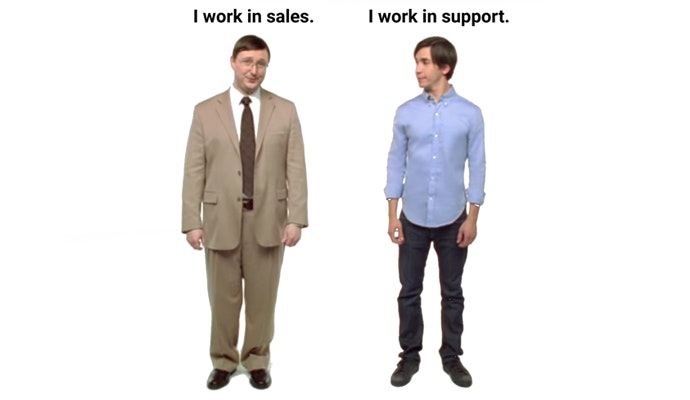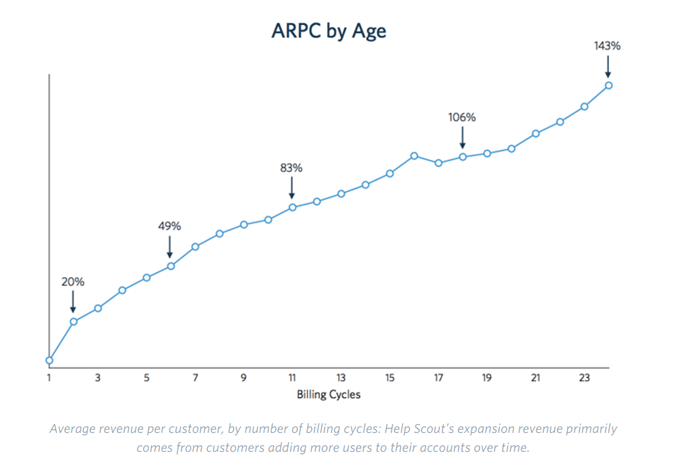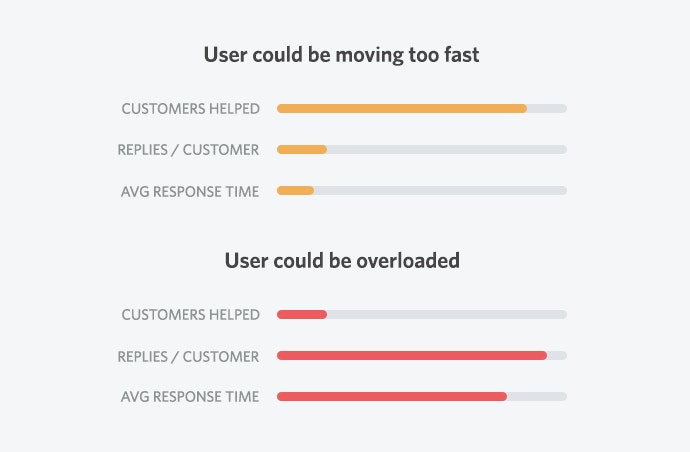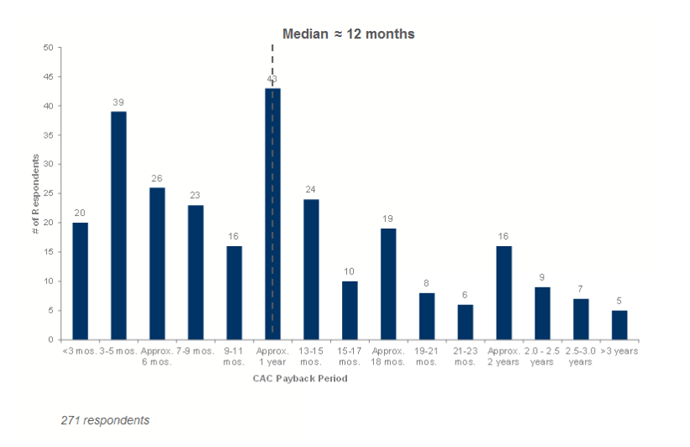There's a massive problem with the way we think about the relationship between sales and support.
Traditionally, sales and support are thought of as two related yet isolated departments.
To assess how well they're doing, we use metrics. We assess salespeople by their velocity, win rate, and time-to-close. We assess support reps by escalation rate, time-to-resolution, and, if we're savvy enough, something like Net Promoter Score. We assume that tracking these metrics will get us faster, more efficient salespeople and support reps — and therefore build a stronger business.
Except, if you run a customer-focused business, you know this is completely wrong. Sales and support are two sides of the same coin, and their incentives need to be aligned if you want to build a company that will achieve sustainable, long-term growth. Otherwise, you get teams that are set up to be at odds with one another — and with your customer.
The wrong incentives misalign sales and support
The most important task for management is to align incentives to unite sales and support rather than divide them. There's a variety of ways to do this, such as organizational structure, compensation, Objective and Key Results (OKRs), and even seating charts. While true success usually requires several (if not all) of the aforementioned, for today, we'll focus on metrics.
Often, we see salespeople incentivized to acquire as many customers as possible because sales is seen as the engine of growth. We see support incentivized to close tickets quickly, because support is seen purely as a cost center. Early in a company's lifecycle, this divide is modest. But if you build on these archetypes, the problem compounds greatly. You get to a point where you have multiple salespeople (if not tens or even hundreds) who are focused on selling by any means necessary, because their job ends when the deal is closed. On the flip side, the customer support team is asked to take on an increasing number of customers at a level of efficiency that is difficult (if not impossible) to maintain.
Who suffers? The customer — sold on high expectations and being supported by a team that's being squeezed and pulled in every direction while trying to meet those expectations. The math rarely works out.
Fixing the handoff is an obvious priority for companies. Retention is the key to sustainable, long-term growth. It behooves companies to shift the focus from what employees do (“I market,” “I sell,” “I support”) to what benefits they provide to the customer, which starts by tracking people's performance differently. It's human nature: “What gets measured gets done.”
Conventional performance metrics like win rate and time-to-resolution are not indicators that your salespeople or support team are creating customer-focused outcomes. They're nothing more than indicators of efficiency — how well, and how quickly, they're doing whatever it is they're doing.
When speed is all that matters, your sales and support teams don't align. Sales will bring in customers who end up disappointed, and support will fail to help them succeed — despite their best efforts. But it's not their fault.

Executives, well aware of the difficulty of managing sales and support, love tinkering with organizational structure, appointing liaisons and generally looking for solutions to the misalignment problem that don't involve fundamentally rethinking the way they approach growth.
And that's exactly where the problem lies.
Fast growth leads to mismanagement
To see how incentives get misaligned, imagine your SaaS business has just closed its post-seed round and your board is reviewing the revenue targets you pitched. “If you can do $10 million with a hundred sales reps,” they say, “you should be able to do $20 million with two hundred.”
So you double the size of your sales team and set higher quotas. Your revenue starts to climb at an even faster rate. You double the size of your support team to make sure things run smoothly. Everything seems to be going well!
Meanwhile, on the ground, your sales and support teams are clashing, creating an intense amount of internal friction and setting the stage for larger problems. Even more salient, however, is the staffing ratio.
Every company wants to go from $10MM to $20MM. Every company acknowledges that sales is a way to get there. Few companies think of the most efficient and sustainable way to do that, because that would mean thinking about the burden of $20MM on teams like marketing, account management — and, you nailed it, support.
When you doubled your sales team, you didn't double how many leads you were getting them — now they're going after every breathing customer out there. And when you doubled your support team, you didn't take into account the increased complexity of each ticket or the communication overhead involved in running such a huge help desk.
Your salespeople are doing whatever it takes to hit their targets. Nonexistent and unplanned features are being promised to customers. Your service is being pushed to anyone and everyone in your market with no qualifications.
Your support team is simply trying to close tickets as fast as humanly possible because there are so many. The most difficult customer problems go untouched since trying to answer them is just going to get your reps negative satisfaction ratings.
This is an alignment problem. It starts with incentives set at the top, flows all the way down the funnel, and culminates in churn rearing its ugly head and sinking your business.

When high-flying startups collapse, it's often because short-term thinking around incentives takes precedence over the patience necessary to build a great business. The agenda is set around hitting internal benchmarks, but those benchmarks have nothing to do with customer success or retention — and a SaaS company can't survive without successful customers.
It's also because when there's a focus on one single metric (revenue, closed tickets), there's no context on quality. When a sales rep is driving revenue, you also have to look at the quality of that revenue (lifetime value, churn rate, etc.) And when the support rep is closing tickets, you want to pay attention to the quality of those interactions (customer satisfaction, Net Promoter Score, and also lifetime value and churn rate, etc.)
Incentivizing customer retention
Some companies focus on selling products and then adding value in return — helping you use the things they told you that you need. But customer-focused businesses are built on retention, so they need to ensure their team has targets or quotas that correlate directly with long-term customer retention. For sales, that could mean the following:
assessing performance based on adding value rather than acquiring new customers
a modified commission structure, i.e. “receive half your commission now and half after a year — if the customer is still around”
looking at ARPU (average revenue per user) rather than booking volume
For example, at Help Scout, we consider sales crucial to how we retain customers, so they do not work on commission; they work regular hours, and their biggest job is not acquisition, but customer retention.
Companies traditionally call this “upselling,” but that term focuses on action, not on customer benefit or customer behavior. We're focused more on helping our customers grow and evolve their businesses, which, if done well, helps our company growth, too.
As Help Scout CEO Nick Francis says,
I never feel bad about selling when it ties directly back to business value for the customer.
By keeping the focus on our customers — rather than the sale — we succeed when our customers get more value out of Help Scout over time. And our average revenue per customer increases steadily from the moment they sign up to two years into their time with us:

Since your revenue can only come from either existing customers or new customers, it will always make sense to take care of your existing customers before acquiring new ones. But you can't do that when your sales team lets go of customers the moment they sign up.
Load balancing your support team
An overloaded support team isn't just going to be slower in responding to customers. By taking less time on each customer, or by leaving difficult requests to just a few reps, they're going to actively disregard the art of forming great customer relationships.
Retention-focused incentives are needed to make sure support teams are building relationships without burning out. That could mean assessing support on a combination of:
replies per customer, overall volume handled, and response time
Net Promoter Score or Happiness ratings
measuring types of conversations split by time spent on them
Tracking how support is doing isn't easy. The Help Scout “Happiness” score, for example, calculated from the “Great,” “OK,” and “Not Good” buttons embedded in each customer email, is effective. But even this can pose problems if it is the only measurement used to set expectations for your support team. If you base support's success on getting “Great” ratings, you can inadvertently cause them to seek out only the easy cases or happy customers, rather than the more difficult cases or frustrated users.
Choosing Happiness or Net Promoter Score as a success metric means you need to make it absolutely clear that you're looking at these scores in context. A support rep who eagerly and effectively takes on corner cases knowing they're unlikely to get a “Great” rating should never be penalized for doing so.
Looking at what customers tell you as a data point, rather than the only data point, provides a more holistic (and accurate) picture of your support team's performance.
One of the most important metrics we use when tracking how support is performing is customer volume vs. average response time and replies per customer:

If support is handling most of the long, difficult support requests themselves, then it's not just an unfair situation for us internally, it's bad for the customer. A rep who's constantly burdened with the most difficult work is not going to be providing customers with the best possible experiences.
Growth management
It's crucial to focus your tracking on metrics that align directly with customer retention. The average SaaS company today needs to keep a customer around for a full year just to recoup the amount they spent to acquire them:

Of course, it's not easy to manage growth and revenue in a customer-focused way, but you can't retain customers for a year at minimum when your sales and support teams aren't working in alignment, either.
Rather than simply extrapolate sales numbers and set targets based on those, your team must sit down with the data and figure out the following:
the cost to support each new user
the cost to onboard each new user
the lifetime value (LTV) of each new user
how much churn they can expect
Use these calculations to avoid setting sales targets that will promote practices that are not customer-centric. Use them to create incentives that will attract customers who will actually get value from your product. Use them to rethink the relationship between sales and support from the ground up, and use them to refocus activities on serving the customer.
Sales, support, marketing, product — these are all activities that we do. They don't matter to our customers. We have spent a tremendous amount of time in 2016 trying to make our success fully and wholly dependent on our customers' success, and we will continue to use that approach in years to come. What matters, what defines success, is helping our customers succeed in making their customers happy. When that happens, we win, too.






